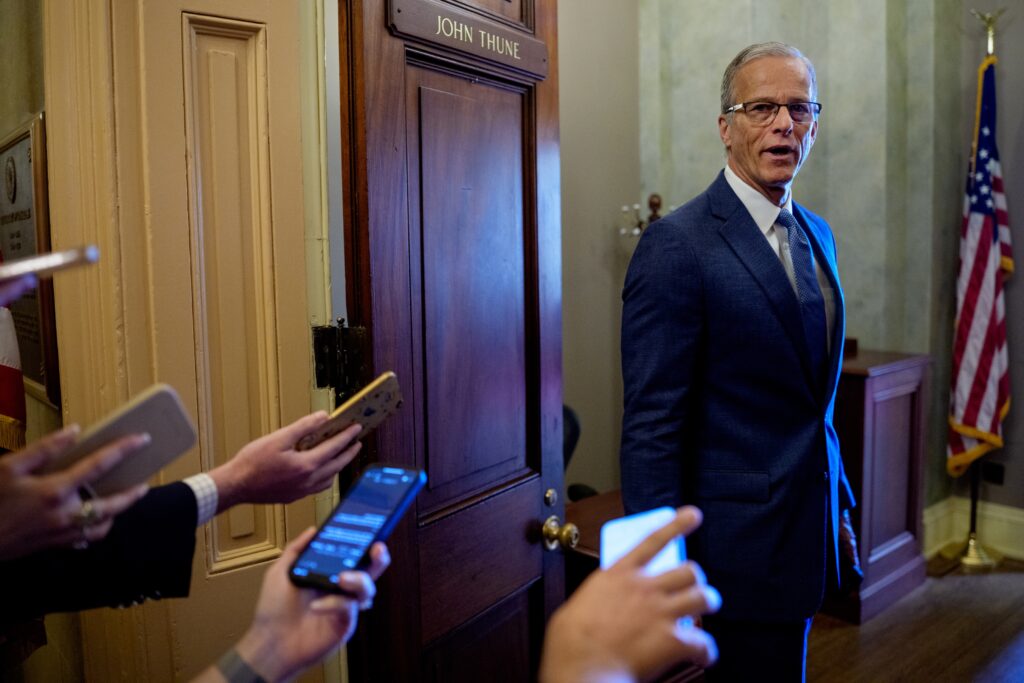
Senate Majority Leader John Thune, R-S.D., speaks to reporters as returns to his office from the Senate chamber at the U.S. Capitol Building on June 30, 2025 in Washington, D.C. (Photo by Andrew Harnik/Getty Images)
WASHINGTON — The U.S. Senate launched a marathon amendment voting session Monday during which lawmakers will debate dozens of proposals from Republicans and Democrats that could significantly reshape the “big, beautiful bill” even as a final vote nears.
The vote-a-rama is expected to last throughout Monday and potentially into Tuesday, challenging senators who aren’t accustomed to having to stay on the floor for all hours of the day and night. At the end, the Senate will vote on final passage and if the tax and spending cut bill is successful it will be taken up next in the House, possibly as soon as Wednesday morning.
The first big debate and vote Monday centered around Republicans’ decision to use current policy instead of current law to determine the bill’s fiscal impacts.
Congress has long used current law to determine how much legislation will add or subtract from annual deficits, especially when it comes to the budget reconciliation process that is being used for this bill.
But since Republicans’ 2017 tax law was set to expire at the end of the year, using the current law baseline showed significantly higher deficits than using current policy — which could prove to be a political problem.
The debate, wonky even for the Senate, could have ripple effects in the future, especially if Democrats ever get unified control of government and use the change in process that GOP lawmakers set this time around for their own policy goals.
Budget Chairman Lindsey Graham, R-S.C., said during brief debate before the vote that using current policy would allow the GOP to make many of the tax levels in the 2017 law permanent, instead of having to sunset them to comply with reconciliation rules.
“What I’m trying to do, and I’m very happy about it, is to make sure the tax cuts don’t expire 10 years from now,” Graham said.
Reconciliation bills cannot increase the deficit after the 10-year budget window ends.
Senate Democratic Leader Chuck Schumer of New York spoke out against using current policy over current law, rebuking his Republican colleagues, though his arguments were ultimately unsuccessful.
“Republicans are doing something the Senate has never done before — deploying fake math, accounting gimmicks to hide the true cost of the bill,” Schumer said. “Look, Republicans can use whatever budgetary gimmicks they want to try to make the math work on paper but you can’t paper over the real-life economic consequences of adding tens of trillions to the debt.”
The nonpartisan Congressional Budget Office released its current law score of the bill on Sunday, showing the legislation would add $3.253 trillion to deficits during the next decade.
Senators voted 53-47 along party lines against overruling Graham’s decision to use current policy.
Narrow majority
Senators spent the next few hours debating Democratic changes to the bill that would have addressed Medicaid and the Supplemental Nutrition Assistance Program. But no Democratic proposals had been adopted as of Monday afternoon and Republicans had yet to start voting on their own amendments.
Once both sides exhaust themselves, the Senate will move on to a final passage vote. With a narrow 53-seat majority, GOP leaders can only afford to lose three members and still have the bill pass with Vice President JD Vance breaking the tie.
Two Republican senators — Thom Tillis of North Carolina and Rand Paul of Kentucky — already indicated they’ll oppose the bill when they voted against advancing it late Saturday night. Altering the bill could cause issues for other senators, making the entire process a headache for GOP leadership.
Senate Majority Leader John Thune, R-S.D., said during a floor speech that the core of the sweeping package is focused on avoiding a cliff created when Republicans approved lower tax rates during President Donald Trump’s first term.
“This is about extending that tax relief so the same people that benefited from it back in 2017 and for the last eight years don’t end up having a colossal, massive tax increase hitting them in the face come January 1,” Thune said.
Schumer sharply criticized the policy changes and spending cuts in the mega-bill, saying they would lead to fewer people being able to access safety-net programs, like Medicaid, which provides health insurance coverage for low-income people and some people with disabilities, and the Supplemental Nutrition Assistance Program, which provides food assistance for low-income people.
“How can any senator go home and tell their constituents, ‘I’m sorry, I took away your health care because I wanted to give tax breaks to billionaires?’” Schumer said. “And yet Republicans are dead set on walking off a cliff by passing a bill they know will be ruinous to their own constituents.”
‘Wraparound amendment’
Depending on how popular an amendment is and exactly what aspects of the legislation it seeks to change, it could increase or decrease the number of GOP senators willing to vote for the final version of the bill.
Republican leaders will want to fend off all Democratic amendments, though if some do get added, Thune can use a procedural tactic called a “wraparound amendment” at the end to cut any problematic changes by wiping out Democratic amendments with a majority vote.
In addition to providing an opportunity for senators to debate nitty gritty policy details, the vote-a-rama serves a political purpose for Democrats, who will try to get at-risk senators to take votes that can then be used during the midterm elections to try to sway voters.
Those amendments will mostly focus on Maine’s Susan Collins after North Carolina’s Tillis announced his retirement Sunday.
While Democrats have more incentive for so-called “gotcha amendments” since they’re trying to flip the Senate from red to blue, GOP leaders may also bring up amendments challenging vulnerable Democratic senators, like Georgia’s Jon Ossoff.
And since the opportunity to put up as many amendments as a senator pleases is rare, both Democrats and Republicans may have an eye on purple-state lawmakers up for reelection in 2028.





